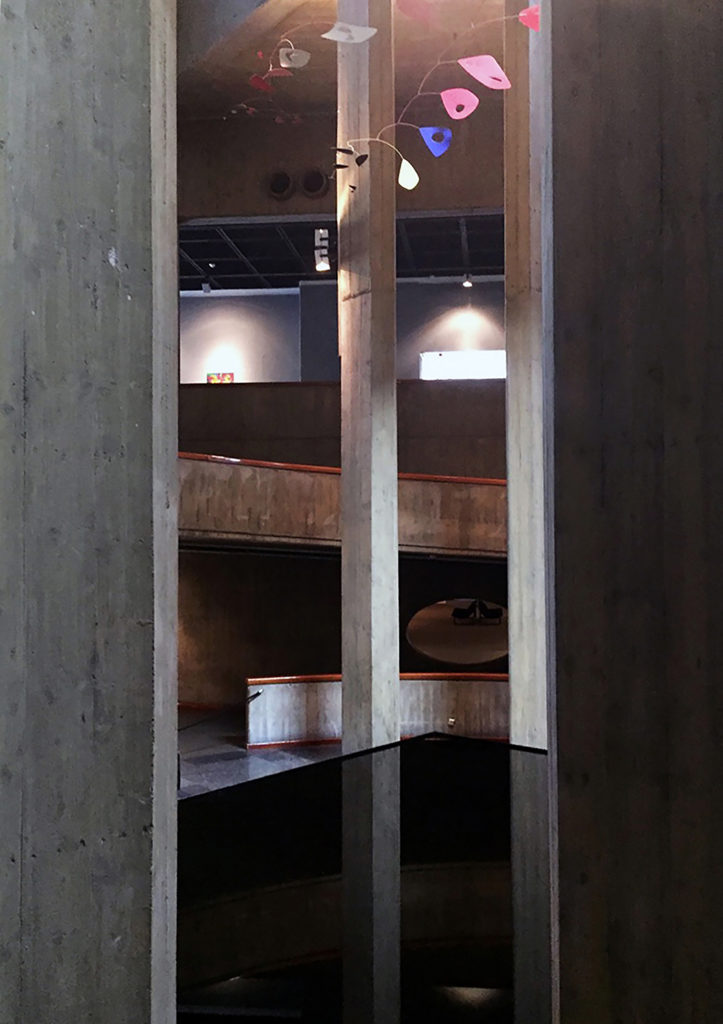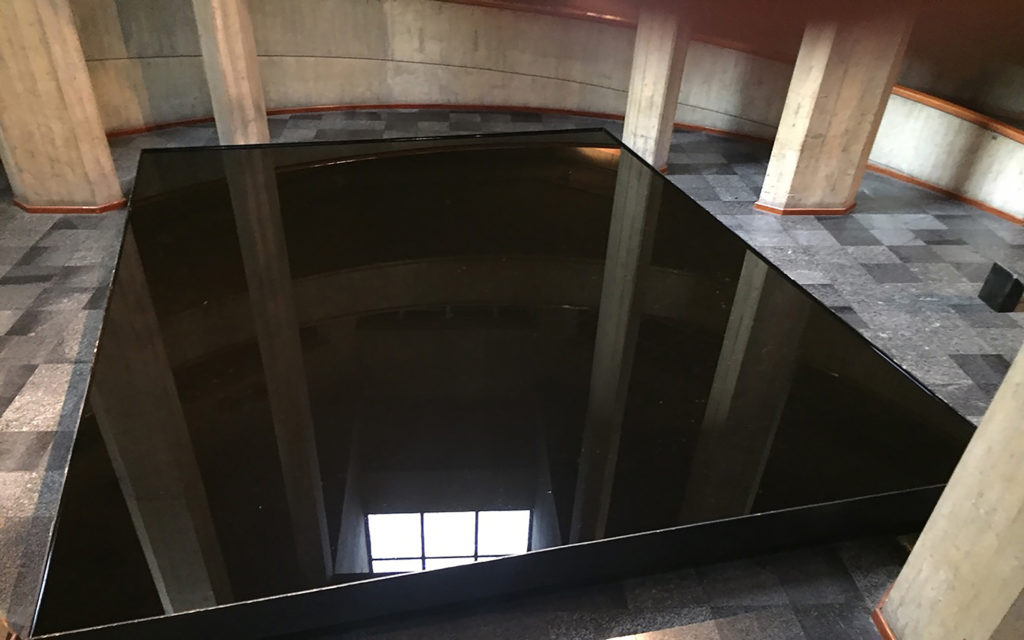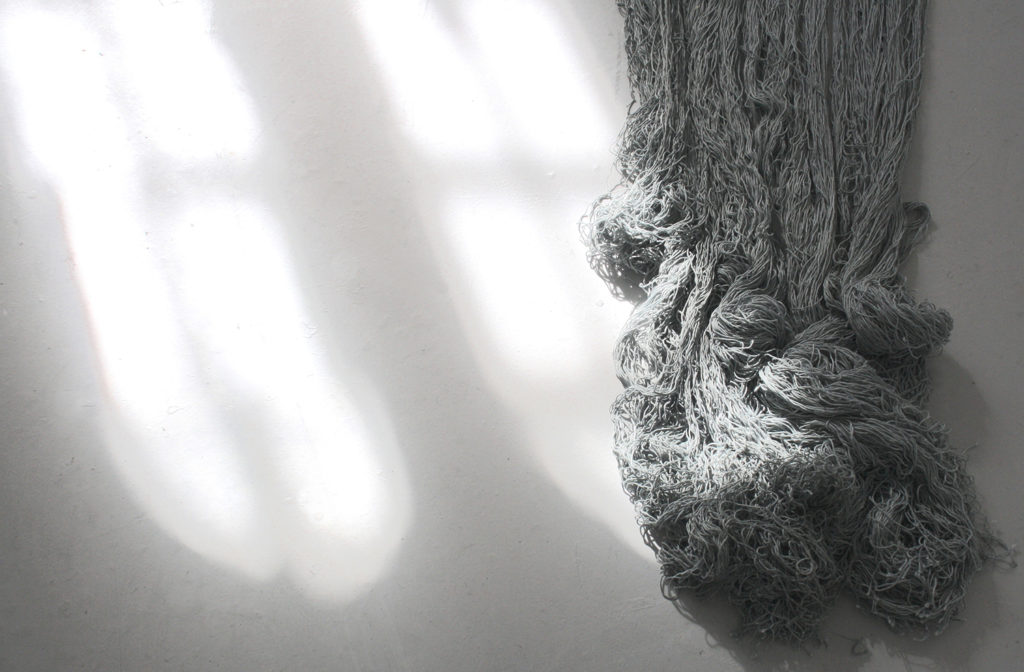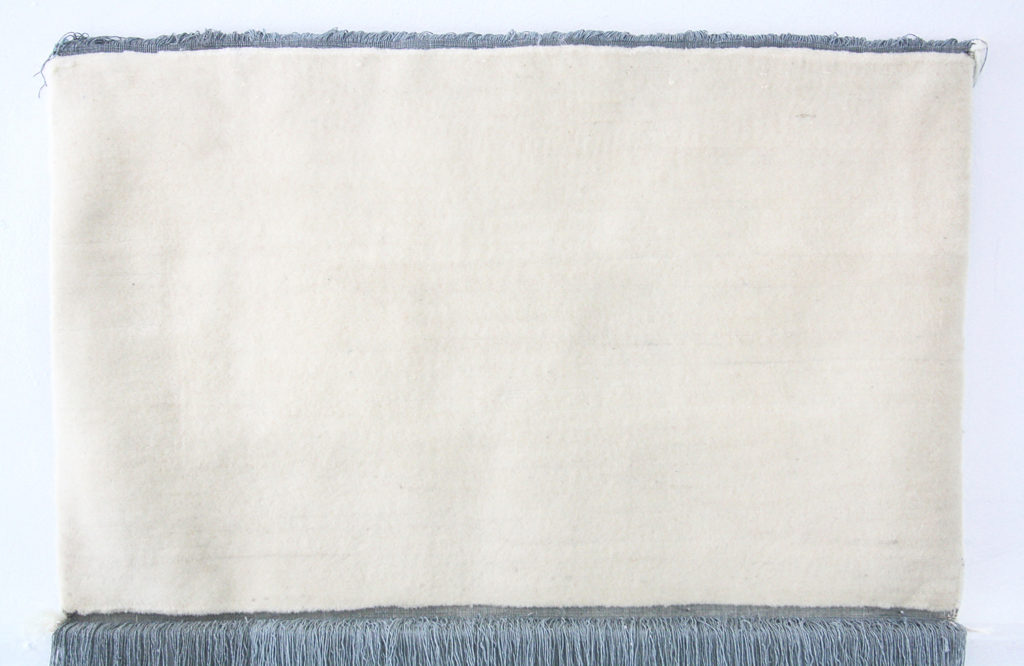jenseits: Place, Dwelling, and Art Practice
Farniyaz Zaker
To cite this contribution:
Zaker, Farniyaz. ‘jenseits: Place, Dwelling and Art Practice.’ OAR: The Oxford Artistic and Practice Based Research Platform Issue 1 (2017), http://www.oarplatform.com/jenseits-place-dwelling-art-practice.
We tend to think of the concept of ‘dwelling’ in relation to places. How and why would we think of dwelling in terms of artworks?
Edward S. Casey identifies two modes of dwelling. One is to dwell physically in a certain place; the other is to dwell mentally in a memorised place.1 In both cases, the bodily experience of a place is a prerequisite for dwelling in it. This fundamentally physical experiencing is also what interests the architect Steven Holl, who argues that ‘architecture, more than other art forms, engages the immediacy of our sensory perceptions.’2 According to Holl, ‘the passage of time, light, shadow and transparency,’ as well as ‘colour, texture, material and detail’ influence the way we feel, see and hear architecture.3 All these factors, he argues, ‘merge perceptually’ in the mind of a dweller and shape his or her spatial perception.4 In this vein, my own art making rests on the belief that the longer we reside in a place, the stronger it affects us; the more intimately we experience a place, the more thoroughly we dwell in it. The philosopher Yi-Fu Tuan describes this process as endowing a place with value.5 To dwell is thus to experience and sense place, to memorise and get to know it, and to let it generate associations within us.
Among my earliest and most intense recollections of experiencing art as a child is my encounter with Noriyuki Haraguchi’s installation Matter and Mind (1977) at the Tehran Museum of Contemporary Art (TMoCA). This large rectangular pool of crude oil – which, incidentally, predates Richard Wilson’s better-known 20:50 (1987) by a decade6 – intrigued me so much that, to the alarm of my mother and the museum staff, I could not resist submerging my hand in it. At least as powerful as its tantalising materiality is the work’s location in a spiral pathway at the heart of the museum, a structure built by the Iranian architect Kamran Diba and inspired by courtyard-house of traditional Iranian architecture. It is as though Matter and Mind was site-specific; as if Haraguchi had created the work with the TMoCA in mind. Haraguchi’s installation sits in its location like a pond at the centre of a courtyard house. It absorbs and mirrors its architectural environment. The glittering pool of oil transforms the audience’s perception of space, and evokes in it a sense of familiarity, domesticity, and dwelling.

Noriyuki Haraguchi, Matter and Mind, 1977, mixed media, installation view, permanent installation at the Tehran Museum of Contemporary Art (TMoCA), photo by the author, 2016.
For me, dwelling and touching are intimately intertwined. Casey’s modes of dwelling highlight the importance of the haptic perception and bodily experience of a place for the development of a sense of dwelling. Furthermore, the architect Juhani Pallasmaa states that ‘the eye is the sense of separation and distance, whereas touch is the sense of nearness, intimacy, and affection.’7 However, since most artworks are visual, for the artist the issue arises as to how viewers might nonetheless be encouraged to dwell within them. This leads me to the question of how our senses interact with each other. According to research by Barry Blesser and Linda-Ruth Salter, a blindfolded person senses when she/he is approaching a wall by paying attention to the changing frequency balance of the background noise.8 Even though that person cannot literally see with her or his ears, she/he does, in a way, see through them. In other words, one sense can, to some degree, be transferred and diverted to another. Pallasmaa makes a similar point when he maintains that eyes can touch, i.e. that our gaze allows us to identify with objects and to grasp them. According to him, our ‘gaze strokes distant surfaces, contours, and edges, [and thereby creates an]…unconscious tactile sensation [that] determines the agreeableness or unpleasantness of the experience.’9 This ‘unconscious tactile sensation’ is reliant on the viewer associating something with this object. In other words, on having previously experienced and committed to memory. Without that mental connection, our vision alone cannot recreate the same sense of touch and intimacy from a distance. For me, Matter and Mindinstantly establishes intimacy and evokes a sense of touch because it reminds Iranian viewers of a place many of them have previously experienced, namely the courtyard-house of traditional Iranian architecture. As a result, some viewers do not just see Matter and Mind – they actually feelthe work. The echoing spiral pathway that winds around the installation, the lingering acrid smell of the oil, its reflective surface, and the fact that the installation and the building of the museum are based on the design of a traditional courtyard house only increase this sensation. The artwork not only engages the viewer’s sense of vision, but also evokes the senses of smell, sound, taste, and touch. The way the artwork and its infrastructure merge transforms the audience’s perception of both the installation and the space around it. The work and its surroundings generate a particular sense of dwelling in the site of the museum and in the artwork. My contention is this: it is impossible to separate our engagement with the artwork from our perception of the space in which it is situated in (and vice versa).
 Noriyuki Haraguchi, Matter and Mind, 1977, mixed media, installation view, permanent installation at the Tehran Museum of Contemporary Art (TMoCA), photo by the author, 2016.
Noriyuki Haraguchi, Matter and Mind, 1977, mixed media, installation view, permanent installation at the Tehran Museum of Contemporary Art (TMoCA), photo by the author, 2016.
The relationship between the body and the built environment informs all of my own artwork which, like architecture, attempts to influence both my own sense of space as well as that of the viewer. My art making seeks to engage the idea that our built environment is not passive, but rather invested with meaning and thus the subjective experience of those who encounter it. The works are always installed with sensitivity to their built environment and, ideally, the work merges with it into what I think of as one architectonic whole. In other words, the work is influenced by the site in which it is installed, and it hopes to influence the way people experience that site. In short, the site of research and the site of output are inextricable in my art making.
Furthermore, for me, the process of producing and installing artwork is always also an act of dwelling. Experiencing the site of an artwork, but also the materials and tools involved in crafting it, are part and parcel of the creative process. Artworks are always a medium through which I experience my built environment. One example is Primeval Relationship I (2014), a work that covers the walls and floor of the gallery with four hand-woven carpets and their elongated fringes. While hand-weaving Primeval Relationship I on a vertical loom, I sensed every knot, the vibration of the woollen piles, cotton warps and wefts, the sharp squeaks of the loom, the materiality and the fragrance of the wool and cotton yarns. According to Pallasmaa, natural materials – unlike synthetic ones – allow the spectator’s ‘gaze to penetrate their surfaces.’10 Following this view, natural materials are thus much more easily touched by the viewer’s eyes in the way described earlier. The wool and cotton of Primeval Relationship I (2014), for example, may evoke a sense of dwelling that is both deeply ingrained in personal experience of space and domesticity and simultaneously recall the history of many ancient cultures. Conceptualising, crafting the work, and the concentration which these processes involved engaged a multitude of senses and allowed me, in my terms set out here, to dwell in it. The process constitutes a ‘transaction between body, imagination, and environment.’11 Primeval Relationship I is not just a work about the concept of dwelling; it also generates a sense of dwelling.
Some dwelling places are so central to my sense of identity, and so rooted in my body and memory, that they unavoidably influence my art practice. Consciously (or not), I recreate, re-experience and ultimately re-dwell in the works. Both the process of making a work which follows such an impulse, as well as the finished product, refresh my memory and allow me to re-dwell in particular places, albeit momentarily. In-between (2008–12), Earthly Paradise (2008–10), jenseits (2013) and Caryatid (2016) exemplify this. They directly relate to places in which I spent a considerable amount of time. jenseits (‘beyond’ in German), for example, is a short video about my childhood room in Tehran. The video consists of four sequenced spaces: a room, a balcony, a garden, and an alleyway. The video starts with an image of a white curtain that veils the balcony, the garden, and the alley. The wind repeatedly opens and closes the curtain, thereby merging these spaces into one unified entity that is neither fully private nor fully public. To recall the words of Victor Turner, it is ‘neither here nor there; it is betwixt and between.’12 In the video, this spectacle continues as the curtain restlessly curls across the boundaries of these fours spaces until the window abruptly shuts and the audience is faced with the image of a motionless curtain. The work speaks of the ambiguous grey area between the private and public that exists in much of contemporary Iranian domestic architecture. jenseits is the result of having experienced this liminal mode of dwelling, and tries to convey this to the audience, as it continues to evoke my own sense of dwelling. The video is not independent from my experience of such places.
 Farniyaz Zaker, Primeval Relationship I, 2014, wool and cotton, 80cm x 2cm x 450cm, installation view, Something There Was That Must Have Loved a Wall, Pi Artworks Gallery, Istanbul, Turkey, 2016.
Farniyaz Zaker, Primeval Relationship I, 2014, wool and cotton, 80cm x 2cm x 450cm, installation view, Something There Was That Must Have Loved a Wall, Pi Artworks Gallery, Istanbul, Turkey, 2016.
 Farniyaz Zaker, Primeval Relationship I, 2014, wool and cotton, 80cm x 2cm x 450cm, installation view, Something There Was That Must Have Loved a Wall, Pi Artworks Gallery, Istanbul, Turkey, 2016.
Farniyaz Zaker, Primeval Relationship I, 2014, wool and cotton, 80cm x 2cm x 450cm, installation view, Something There Was That Must Have Loved a Wall, Pi Artworks Gallery, Istanbul, Turkey, 2016.
For Tuan, a place is ‘a special kind of object. It is a concretion of value…an object in which one can dwell.’13 Artworks can also be such concretions of value. Some can be dwelt in physically; others provoke a sense of dwelling in the minds of artists and audiences. As such, they heighten our awareness of how ‘place-oriented and place-saturated’ our lives are, to recall the thoughts of Casey.14 I hope jenseits encourages viewers to experience a particular mode of being within a liminal space that is not confined to the privacy of one’s own four walls, and that it generates a sense of oscillation between the public and private sphere. In the same way, Primeval Relationship I is not only a reflection on the historical and deep link between architecture and textiles;15 its four carpets also suggest of a room and an experienced domesticity, thereby hoping to evoke a sense of dwelling in the audience.
Farniyaz Zaker, jenseits, 2013, video, 04’23”, The Wall of Europe, Paese Museo, San Sperate, Sardinia, Italy, 2013.
1. Edward S. Casey, Getting Back into Place, Toward a Renewed Understanding of the Place-World (Bloomington and Indianapolis: Indiana University Press, 1993), 112–14.
2. Steven Holl, ‘Questions of Perception: Phenomenology of Architecture,’ in Questions of Perception: Phenomenology of Architecture, ed. Steven Holl, Juhani Pallasmaa abd Alberto Pérez-Gómez (San Francisco: William Stout Publishers, 2006), 41.
3. Ibidem.
4. Idem, 45.
5. Yi-Fu Tuan, Space and Place: The Perspective of Experience (Minneapolis: University of Minnesota Press, 1977), 6.
6 Haraguchi executed his first oil pool installation in 1971; later he exhibited another version of the work at Documenta 6, 1977, which was subsequently acquired by the Tehran Museum of Contemporary Art (TMoCA).
7. Juhani Pallasmaa, ‘An Architecture of the Seven Senses,’ in Questions of Perception: Phenomenology of Architecture, ed. Steven Holl, Juhani Pallasmaa abd Alberto Pérez-Gómez (San Francisco: William Stout Publishers, 2006), 34.
8. Barry Blesser and Linda Ruth Salter, Spaces Speak, Are You Listening? Experiencing Aural Architecture (London: MIT Press, 2007), 1. Another prominent example illustrating this complex interconnection of our sensory system is the renowned deaf-blind American art historian Mary Keller (1880–1968), who could hear the music by feeling the beat, and see the water by touching it.
9. Pallasmaa, Questions of Perception, 34.
10. Idem, 29.
11. Kent C. Bloomer and Charles W. Moore, Body, Memory, and Architecture (London: Yale University Press, 1997), 105.
12. Victor W. Turner, The Ritual Process: Structure and Anti-Structure (London: Routledge and Kegan Paul, 1969), 95
13. Tuan, Space and Place, 12.
14. Casey, Getting Back into Place, ix, 15.
15. I am referring to the argument of the German architect and art critic Gottfried Semper (1803–79), according to whom primitive architectural places were made from textiles, fabrics, and carpets. Therefore, for him, today’s walls are the successors to earlier clothes, carpets, and other textiles. See: Gottfried Semper, The Four Elements of Architecture and Other Writings, trans. Harry Francis Mallgrave and Wolfgang Herrmann (Cambridge: Cambridge University Press, 1989), 246–7.
